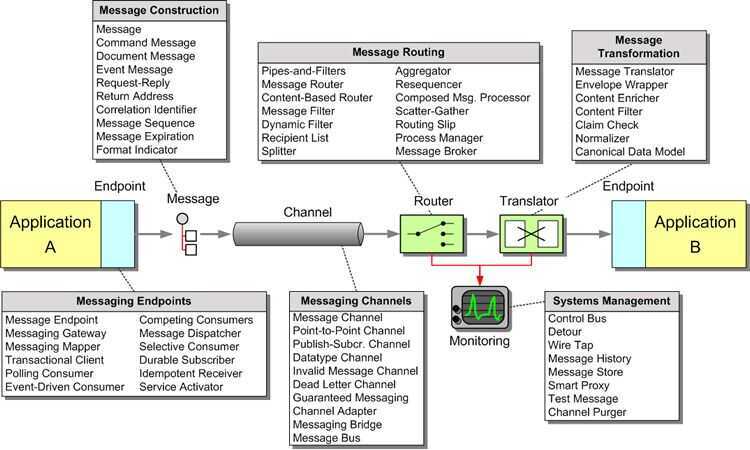Enterprise Integration Patterns
The patterns provide technology-independent design guidance for developers and architects to describe and develop robust integration solutions.

- https://www.enterpriseintegrationpatterns.com/patterns/messaging/index.html
- https://www.enterpriseintegrationpatterns.com/patterns/messaging/toc.html
ESB vs Message Brokers
Enterprise service buses (ESBs) and message brokers are both messaging middlewares that help applications communicate with each other. They have different strengths and weaknesses, so it's important to consider your needs when choosing between them:
ESBs
These are built on a central system and are well suited for complex application designs. They focus on higher-level communication patterns like publish/subscribe, request/response, and message transformation. ESBs also provide a higher-level abstraction, often including business-level features and logic. They can be a good choice for simple solutions for monolithic applications or apps with few services. ESBs also have robust transactional handling capabilities.
Message brokers
These are better suited for simple asynchronous communication and can handle many-to-many communication between distributed microservice applications. They focus on message routing, delivery, and ensuring reliable communication between applications. Message brokers are a good choice for processing online orders because they can enhance fault tolerance and guarantee that messages are consumed only once. They can also be used to protect sensitive data at rest and in transit.
Message Brokers vs. Enterprise Service Buses | Baeldung on Computer Science
Enterprise Service Bus vs. Message Brokers vs. EAI vs. SOA
Enterprise Architectures
TOGAF, Zachman, and FEAF are all frameworks for enterprise architecture, but they differ in their scope and focus. TOGAF is a comprehensive methodology for developing enterprise architectures, while Zachman provides a classification framework for understanding different aspects of an enterprise. FEAF is specifically tailored for U.S. federal agencies.
TOGAF (The Open Group Architecture Framework)
- Focus: Provides a detailed methodology for developing and managing enterprise architectures, emphasizing flexibility and adaptability.
- Key Features: Includes the Architecture Development Method (ADM), which guides architects through various development phases.
- Strengths: Comprehensive, process-oriented, and adaptable to various industries and business contexts.
- Best Suited For: Organizations seeking a structured approach to building and managing their enterprise architecture.
Zachman Framework
- Focus: A classification framework that categorizes enterprise architecture artifacts based on different perspectives (who, what, when, where, why, and how).
- Key Features: Uses a matrix structure to organize information related to different stakeholders and their viewpoints.
- Strengths: Provides a structured way to understand and manage enterprise architecture, promotes communication, and identifies key stakeholders.
- Best Suited For: Organizations needing a clear, structured way to understand and organize their enterprise architecture, especially when dealing with complex or large organizations.
FEAF (Federal Enterprise Architecture Framework)
- Focus: Specifically designed for U.S. federal agencies to improve interoperability, resource management, and strategic alignment.
- Key Features: Includes reference models and a framework for developing architectures that align with federal policies and objectives.
- Strengths: Tailored for the unique needs of government operations, promotes standardization and efficiency.
- Best Suited For: U.S. federal agencies and other public sector entities.